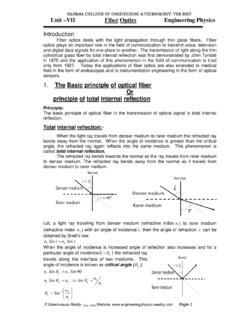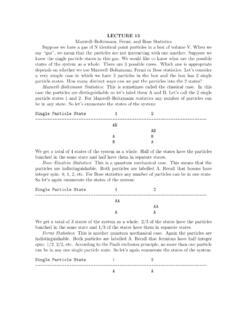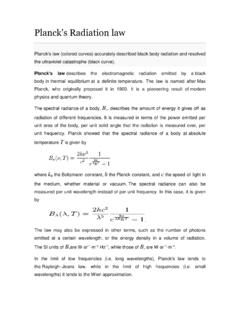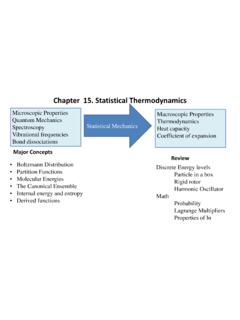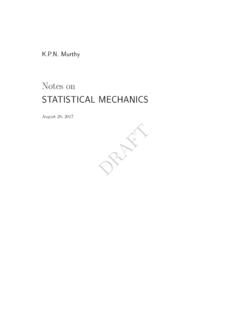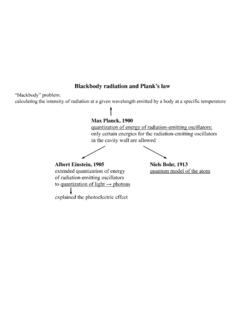Transcription of Unit –I LASER Engineering Physics - Applied Physics
1 Unit I LASER Engineering Physics Introduction LASER stands for light Amplification by Stimulated Emission of Radiation. The theoretical basis for the development of LASER was provided by Albert Einstein in 1917. In 1960, the first LASER device was developed by Mainmann. 1. Definitions Stimulated absorption (or) Absorption Let 1 Eand 2 Ebe the energies of ground and excited states of an atom. Suppose, if a photon of energy hEE= 21 interacts with an atom present in the ground state, the atom gets excitation form ground state1E to excited state2E. This process is called stimulated absorption Stimulated absorption rate depends upon the number of atoms available in the lowest energy state as well as the energy density photons.
2 Stimulated absorption rate number of atoms in the ground state Density of photons Spontaneous emission Spontaneous emission was postulated by Bohr. Let 1 Eand 2 Ebe the energies of ground and excited states of an atom. Suppose, if a photon of energy hEE= 21 interacts with an atom present in the ground state, the atom gets excitation form ground state1E to excited state2E. The excited atom does not stay in a long time in the excited state. The excited atom gets de-excitation after its life time by emitting a photon of energy hEE= 21. This process is called spontaneous emission. The spontaneous emission rate depends up on the number of atoms present in the excited state.
3 Spontaneous emission rate number of atoms in the excited state Unit I LASER Engineering Physics Stimulated emission Stimulated emission was postulated by Einstein. Let 1 Eand 2 Ebe the energies of ground and excited states of an atom. Suppose, if a photon of energy hEE= 21 interacts with an atom present in the ground state, the atom gets excitation form ground state1E to excited state2E. Let, a photon of energy hEE= 21interacts with the excited atom with in their life time; the atom gets de-excitation to ground state by emitting of another photon. These photons have same phase and it follows coherence.
4 This phenomenon is called stimulated emission. Stimulated emission rate depends upon the number of atoms available in the excited state as well as the energy density of photons. Stimulated emission rate number of atoms in the excited state Density of photons Spontaneous and Stimulated emission Spontaneous emission Stimulated emission 1. The spontaneous emission was postulated by Bohr 1. The stimulated emission was postulated by Einstein 2. Additional photons are not required in spontaneous emission 2. Additional photons are required in stimulated emission 3. One photon is emitted in spontaneous emission 3. Two photons are emitted in stimulated emission 4. The emitted radiation is poly-monochromatic 4.
5 The emitted radiation is monochromatic 5. The emitted radiation is Incoherent 5. The emitted radiation is Coherent 6. The emitted radiation is less intense 6. The emitted radiation is high intense 7. The emitted radiation have less directionality Example: light from sodium or mercury lamp 7. The emitted radiation have high directionality Example: light from LASER source. 2. Characteristic of LASER radiation The LASER light exhibits some peculiar properties than compare with the convectional light. Those are 1. Highly directionality 2. Highly monochromatic 3. Highly intense 4. Highly coherence 1. Highly directionality Unit I LASER Engineering Physics The light ray coming ordinary light source travels in all directions, but LASER light travels in single direction.
6 For example the light emitted from torch light spreads 1km distance it spreads 1 km distance. But the LASER light spreads a few centimeters distance even it travels lacks of kilometer distance. The directionality of LASER beam is expressed in terms of divergence Where and are the radii of LASER bam spots at distances of and respectively from LASER source. 2. Highly monochromatic The LASER light is more monochromatic than that of a convectional light source. This may be duet to the stimulated characteristic of LASER light. The band width of convectional monochromatic light source is 1000A0. But the band width of ordinary light source is 10 A0. For high sensitive LASER source is 10.
7 3. Highly intense LASER light is highly intense than the convectional light. An one milliwatt He-Ne LASER is highly intense than the sun intensity. This is because of coherence and directionality of LASER . Suppose when two photons each of amplitude are in phase with other, then young s principle of superposition, the resultant amplitude of two photons is 2 and the intensity is 4 . Since in LASER many number of photons are in phase with each other, the amplitude of the resulting wave becomes and hence the intensity of LASER is proportional to . So 1mW He-Ne LASER is highly intense than the sun. 4. Highly coherence Definition:- A predictable correlation of the amplitude and phase at any one point with other point is called coherence.
8 In case of convectional light, the property of coherence exhibits between a source and its virtual source where as in case of LASER the property coherence exists between any two of more light waves. Unit I LASER Engineering Physics Dr. Reddy , PhD Website: Page 4 P1 P2 There are two types of coherence i) Temporal coherence ii) Spatial coherence. Temporal coherence (or longitudinal coherence):- The predictable correlation of amplitude and phase at one point on the wave train w .r. t another point on the same wave train, then the wave is said to be temporal coherence To understand this, let us consider two points 1 Pand 2 Pon the same wave train, which is continuous as in shown in figure (1).
9 Suppose the phase and amplitude at any one point is known, then we can easily calculate the amplitude and phase for any other point on the same wave train by using the wave equation sin 2 ! Where a is the amplitude of the wave and x is the displacement of the wave at any instant of time t . Spatial coherence (or transverse coherence) The predictable correlation of amplitude and phase at one point on the wave train w. r .t another point on a second wave, then the waves are said to be spatial coherence (or transverse coherence) Two waves are said to be coherent, the waves must have 3. Population inversion Definition The number of atoms present in the excited (or higher) state is greater than the number of atoms present in the ground state (or lower) state is called population inversion.
10 Or The population present in the excited (or higher) state is greater than the population present in the ground state (or lower) state is called population inversion. Let us consider two level energy system of energies " and " as shown in figure. Let # and # be the populations (means number of atoms per unit volume) of energy levels " and " . According to boltzmann s distribution the population of an energy level E, at temperature T is given by #$ # %& '()*+ Where # is the population of the lower level or ground state and k is the boltzmann s constant. From the above relation, the population of energy levels " and " are Unit I LASER Engineering Physics # # %& ',)*+ # # %& '-)*+ At ordinary conditions #.
